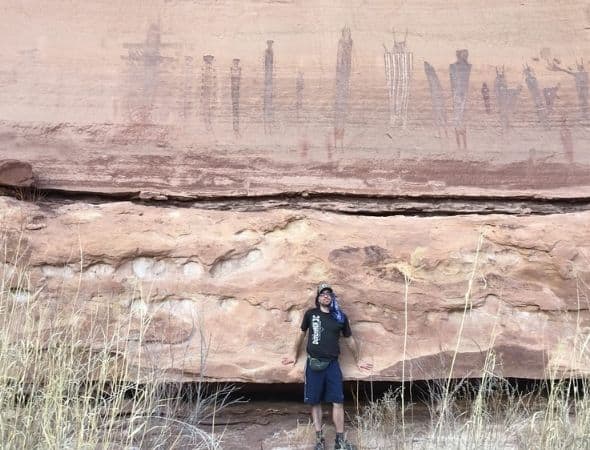Getting Lost in “The Maze”
by Nathan Lincoln de Cusatis
From Olivier Messiaen’s “Des Canyons aux étoiles…” to Maynard Dixon’s landscapes of Utah’s red rock, our state is not lacking in artistic inspiration. No wonder so many of our orchestra musicians—including Concertmaster Madeline Adkins—chose to make Utah their home!
A few years ago, Madeline reached out to composer Nathan Lincoln de Cusatis, a fellow lover of the outdoors, about writing a concerto inspired by her newfound home. De Cusatis, in addition to being a composer, is an adventurous outdoorsman and skilled hiker who found himself inspired by The Maze District of Canyonlands National Park—one of the most dangerous hikes in North America.
About the Maze
The Maze is a violin concerto about one of Utah’s most spectacular wild places: The Maze District of Canyonlands National Park, famous for its intricate network of interlocking canyons filled with ancient pictographs, natural arches, and monolithic rock formations.
Madeline and I are both big outdoor enthusiasts who love hiking and exploring. When she asked me to write a violin concerto for her to play with the Utah Symphony, I immediately thought of taking one of Utah’s iconic natural landscapes and using it as inspiration for a new work with Madeline’s solo violin acting as a musical guide through the wilderness.
The opportunity presented itself in March, 2019 when I spent a week backpacking through The Maze. I wrote this piece to try to capture the mystery and magic of what I found there, and each of the piece’s four movements evokes one of my favorite moments from the trip.

Echoes
Starting with the first movement “Echoes” Madeline plays a fast, shimmering arpeggio that echoes through each stand of the violin section. This idea came from standing at the canyon edge, letting out a loud “ah-ooooh!” and listening to the intricate echoes ricochet off the canyon walls, as if the canyon were a gigantic acoustic chamber like the inside of massive geological violin. You’ll hear this idea comes back three more times throughout the piece; it’s kind of like the violin concerto is itself a maze, and Madeline keeps getting lost in it to find herself back where she started!
Maze Overlook
The second movement is about the iconic “Maze Overlook” where you can see out over the entire canyon system. Here I wrote an “erosion scale” that starts in the highest notes of the piccolos and winds its way all the way down to the basses. The big moment at the end of this movement pays homage to the canyon as “nature’s cathedral” with a big organ-like statement in the whole orchestra after Madeline furiously climbs down into The Maze with a series of virtuosic passages.

Pictographs
The third movement “Pictographs” is about the Harvest Scene pictograph gallery at the bottom of The Maze canyon system. The big crashing sound with a residue of violin and flute glissandos evokes the massive, horned anthropomorphic figures painted in red ochre on the canyon walls by the Fremont people about 1,000 years ago. The middle section is full of short, colorful gestures in the orchestra and solo violin that are like a tour down the gallery that is full of different pictographs of animals, birds and mysterious symbols emerging from the canyon wall.


The Confluence
The final movement is a furious toccata called “The Confluence” about the point where the Green and Colorado rivers meet in a massive canyon that divides the three quadrants of Canyonlands National Park. The two rivers are represented by different rhythmic subdivisions: the Green by groups of two and the Colorado by groups of three. Madeline’s rapid-fire solo sections in this movement keep leaping back and forth between these two “rivers” as she rides towards the confluence in the big, final climax where the horns play a soaring melody over the entire orchestra.
Leaving The Maze
The final movement ends with a short cadenza by Madeline and a coda that is like a memory of the first “echoes” idea from the piece’s opening. The final unison bang in the full orchestra ends our journey after Madeline plays a lightning-fast rising arpeggio to finally find her way out of The Maze.
Get lost in the music with us. Get your tickets for Thierry Fischer Conducts Rachmaninoff, Honegger & Nathan Lincoln De Cusatis here.











